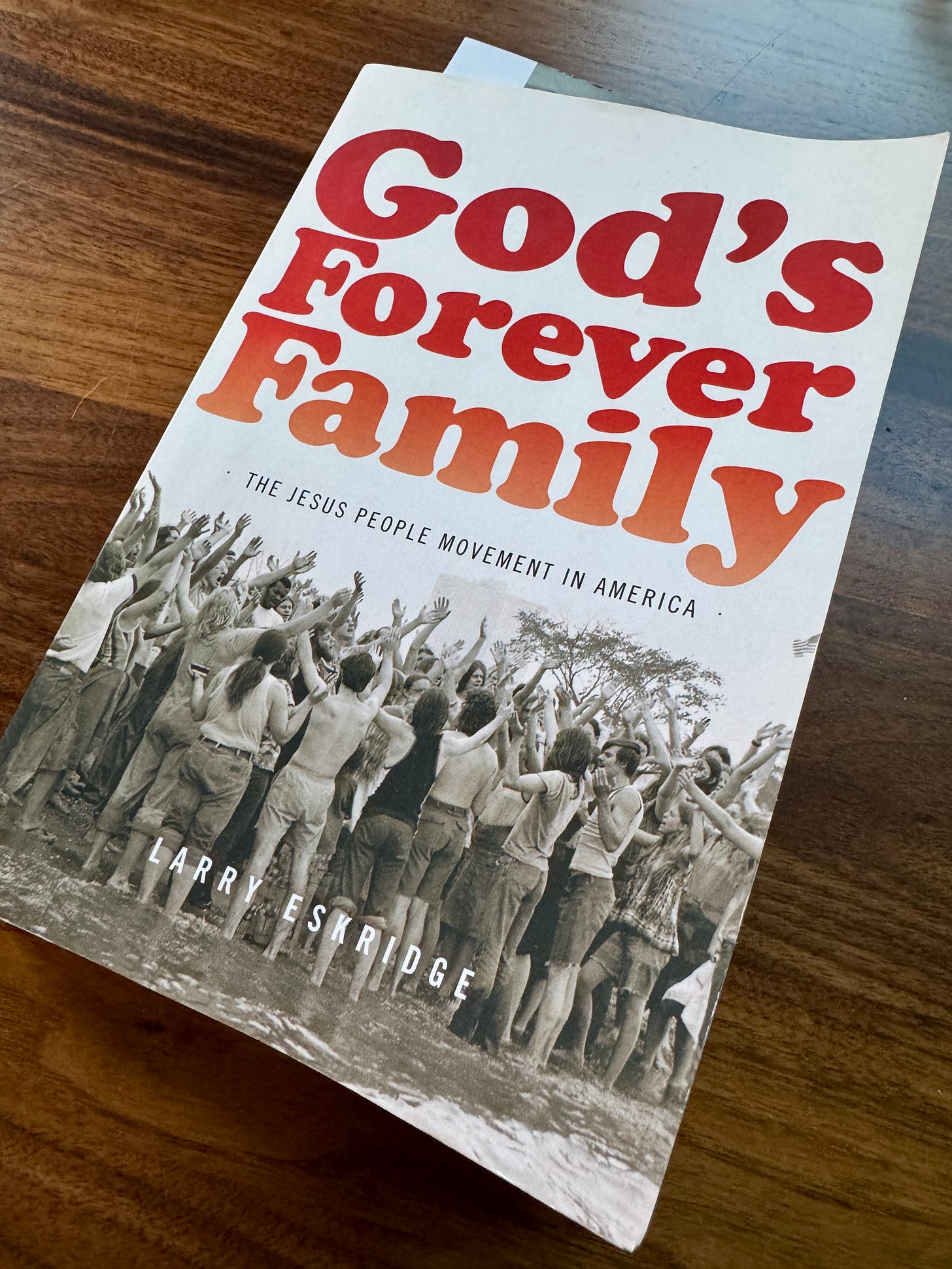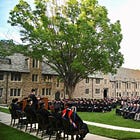The Adiaphoristic Goldilocks Zone
LCMS laity must be on high alert to sleights of hand regarding adiaphora, which deliberately makes the term too hot or too cold, corroding good order, Christian discipline, and evangelical propriety.
Fifteen years after the LCMS’s last major eruption over what is and is not adiaphora, the Synod is back at it with a new intensity. This time, the stakes are higher because the renewed drama seems to be based on providing additional justifications for exiting the LCMS, as we recently wrote about:
Building Exits from the LCMS
A high-altitude observer of the LCMS might conclude that multiple exits are currently under construction to funnel parishioners and assets away to one or more new church bodies. The reason for all the building is that the “Missional” side of the LCMS chafes against the commonly held and understood forms, symbols, and systems of the Synod’s Lutheran iden…
For example, the upcoming Michigan District convention (June 22–24, 2025) has several overtures dealing with adiaphora1, and you will hear the term regularly via the media of the Missional faction of the Synod. A shorthand version of the Missional approach to adiaphora might be, “The traditional way of doing church is neither commanded nor forbidden in God’s Word. Therefore, our contemporary practices are fine.”
However, you rarely hear adiophora discussed with its critical qualifier, “genuine adiaphora”2. In other words, there is a legitimate and an illegitimate application of adiaphora. The Formula of Concord, Solid Declaration (FC-SD) clarifies that goals and motives determine legitimacy in light of 2 Cor. 6:14-173:
When traditions, customs, or ceremonies are used to give the impression that our true religion/pure doctrine (Justification by faith alone through the atoning sacrifice of Christ alone) does not significantly differ from that of the papists [and, by inference, all contrary religions] then we are not free to use those customs even if, under different circumstances, the ceremonies would be indifferent matters.
When traditions, customs, or ceremonies are used to imply contrary religions are reconciled, such customs or ceremonies cease to be matters of indifference (FC-SD X 5).
When traditions, customs, or ceremonies corrode good order, Christian discipline, and evangelical propriety, they are not genuine adiaphora (FC-SD X 7).
When traditions, customs, or ceremonies are modified without careful consideration to avoid causing offense, degrading Christian discipline, and advancing the edification of the Church (FC-SD X 9)
The Confessions warn that illegitimate adiaphora are introduced in two ways:
By oppression and violence (raw civil and judicial power or intimidation).
By deceit and cunning (the voice of the serpent to Eve).
Two methods with one purpose: to get us to yield to the adversaries and enemies of the one true gospel, which always results in undermining the true worship of God, which goes hand-in-hand with the introduction and sanction of idolatry. (FC-SD X 10), either rapidly or gradually.
Finally, the Augsburg Confession (AC) requires that our corporate (walking together in fellowship) conduct should be mindful of, in cases of legitimate adiaphora:
Avoiding contentiousness for love's sake, even where the adiaphora might be considered disadvantageous.
Striving for public harmony and avoiding binding consciences. (AC XV 52)
Church body identity detecting
Scripture and our Confessions neither command nor forbid a drum set and projection screens in front of a church—ditto chasubles, stoles, hymnals, organs, English, KJV only, paraments, banners, acolytes, lectionaries, choirs, ad infinitum. However, we must investigate each adiaphoron's (“an alternative expression”) goal and motivation.
The detective must begin his task with pattern recognition, applying three primary questions:
Are alternative expressions a deviation from what is traditional?
Where else do alternative expressions originate and manifest?
What are the consequences of the alternative expressions?
Question 1: Standard and non-standard deviations
For centuries, Lutheran church bodies have heavily invested in developing, printing, translating, and distributing common service books that comprise orders of service, rites and ceremonies, lectionaries, prayers, hymns, psalms, and so on. Lutherans have also expended blood to produce and defend a set of Confessions that have withstood repeated assaults for half a millennium.
The detective can deduce that the goal and motivation of these efforts were to establish what is normative. They set forth an unambiguous public identity based on the authority of Scripture that is the foundation for walking in true fellowship regardless of time and space. Everyone within and without the church body can know what is believed, taught, and confessed therein.
So, to have any hope of defining Lutheran identity, you must start with what is most held in common: the hymnal in the pews. Then, you examine how the hymnal is used in practice, and what surrounds that practice, including how the teaching and preaching proceed, considerations of architectural aesthetics, and how the Divine Service is adorned to help us better receive God’s gifts of salvation and life together. Each Synod’s Hymnal provides the taxonomy for assessing whether the identity is Lutheran or something altogether different.
Only very recently did some in our body decide to jettison the formal and announced boundaries of Lutheran identity, which provided the means, trust, and reason to walk together in fellowship. Those fixed markers have been exchanged for articulations of disunity, if not disfellowship, where every congregation does what is right in its own eyes.
The alternative expressions have no solid identity because there is no hymnal to examine, which means no dependable liturgical consistency is being communicated to the parishioners. That brings into question the Confessional subscription. The displacing “contemporary and contextual” Lutheran identity quivers like a badly set potluck jelly, trembling and wobbling in response to every flutter of fashion in the CCLI oeuvre, garnished with secular concert performance aesthetics.
Question 2: Origins and manifestations
Now that we have established that alternative expressions depart from normative standards, we might try pinpointing the innovations' origins. Unfortunately, America has a unique and long history of radical religious innovation that should cause us to be resistant to change. There are five principal forms of American religious innovation:
Manufacturing new religions (e.g., Rosicrucians, Latter Day Saints, Scientology, Church of Satan, etc.).
Theological tampering, which takes three primary forms:
Deforming orthodoxy (e.g., ELCA, SDA, JWs, Latter Rain, etc.), and/or
Distorting orthopraxy (e.g., Contemporary Christian Music, Charismatic Renewal, etc.), and/or
Elevating orthopathy (e.g., Rick Warren, John Piper, Gospel Coalition, Jesus First, Congregations Matter, Five Two, etc.)
Cultural capitulation (“we lose down here”, relational Christianity, separation of church and state, rationalizing cultural malaise, etc.)
Revivalism (Billy Sunday, William Seymour, Charles Finney, George Whitfield, Promise Keepers, etc.)
Becoming acolytes of charismatic cultists who seem to have a predilection for copious sexual deviancy, subdividing into two categories:
Credulous attachment (Aimee Semple McPherson, Warren Jeffs, Amy Carson, Bhagwan Shree Rajneesh, etc.)
Millenerian devotion (Jim Jones, Marshall Applewhite, David Koresh, William Miller, etc.)
Alternative expressions in the LCMS are most visible as theological tampering across all three subtypes. They are dominated by deviations from orthopraxy and an orthopathic obsession with “hospitality” at any price, which Pr. Larry Beane analyzes so well in ‘Beware of “Hospitality”’. There is also evident bleed from cultural capitulation and revivalism.
Long-accepted Lutheran identity has been oxidized by solvents conceived at the libidinous intersection of LSD and Free Love in San Francisco, before they drifted to Southern California in pursuit of adulthood, respectability, and an annuity income.
Consequently, contemporary worship forms in the LCMS are an alien invasive species with no indigenous precedent or root. They mimic what the Evangelical churches, especially those propagated by the Jesus People, pioneered in promoting a personalized experiential and sensory connection to Jesus to cultivate a “receptive heart”.
As synergists, it is no accident that Evangelical worship arrangements pursue a liturgy of emotional calibration. They marionette the parishioner through ecstatic to woebegone with tempo control, intense colored lighting over stage sets but low lighting over the audience, and promotion of demonstrative expression governed by a performance artist.
The overlap with secular concert culture is deliberate because entertainment attracts and pleases crowds searching for dopamine hits. Evangelical Sunday services have become essentially indistinguishable from Saturday night rock concerts, which range from impressive high-budget stadium productions to cringeworthy coffee shop crooning by a B team.
The goal and motive for concert-styled services make them illegitimate adiaphora. The contemporary alternative deliberately inverts traditional Lutheran worship because it is aping the synergists who demand that you bring God your gifts, for which He has no need. In contrast, the design and execution of traditional Lutheran liturgies are to enable the parishioner to receive God’s gifts in an orderly, reverent, and edifying manner. They have precedent in Old Testament worship, providing continuity and fellowship with the Christians of prior generations.
It is not a matter of instrumental preference. The packaging of the contemporary service in a Lutheran church corrupts the accepted and long-established Lutheran identity. It violates FC-SD X 7, which requires good order, Christian discipline, and evangelical propriety.
Adopting casual and contemporary worship is ultimately a symptom of a much deeper theological malaise that has plagued the LCMS for the better part of a century. Nevertheless, the uptake of groovy worship was as decisive an attack on Lutheran identity as Seminex because it was a potent solvent that weakened bonds of unity and familiar expressions of fellowship, causing a great deal of offense and degrading edification.
Question 3: Consequences
Lutheran identity cannot be reduced to just the sacraments. However, sacramental reductionism, the kissing cousin of Gospel Reductionism, is a hallmark of casual and contemporary congregations. Despite the claims to hold steadfastly to Lutheran identity, sacramental reductionism produces results and behaviors that erode and even contradict our theology.
To look at possible patterns in the reductionist portion of the Synod, we surveyed the ten largest (by baptized membership) congregations in the LCMS (see below). The results were alarming, surfacing a pattern of Reformed practices with soft pastel allusions to the Real Presence. Even when the sacraments are exercised, there are some very disturbing implementations.
The survey revealed that even non-negotiable elements of the liturgy have been heavily diluted or entirely abandoned in contemporary churches despite the insistence on fidelity to all things Lutheran. The reason for doing so seems to be an explicit desire to avoid being tagged with a Lutheran identity in locations heavily populated by Evangelicals and Baptists, i.e., the goal and motivation are to become more like those churches.
The solvent effect on Lutheran identity plays out in other ways, for example the attitude and approach to the Office of Holy Ministry, which we discussed here:
Conclusion
The intensifying debate over adiaphora in the LCMS is symptomatic of a deeper struggle over Lutheran identity, unity, fellowship, and fidelity to Scripture and the Confessions. As convention season proceeds toward the national convention in Phoenix next year, the LCMS laity must be well informed and alert to attempts to dilute Lutheran identity with illegitimate adiaphoristic classifications.
The Formula of Concord warns against illegitimate adiaphora that obscure the Gospel, promote disunity, or compromise Christian discipline. That means we either have normative standards of Lutheran worship and theology rooted in an authentic subscription to Scripture and the Confessions, or we don’t. There either is or is not an essential Lutheran identity that takes us to the Lord’s Supper together in good conscience.
☩TW☩
Michigan District Convention Overtures Dealing with Adiaphora
Overture 2–03: Define and Affirm Lutheran Identity
The overture asserts that Lutheran identity is not dependent on differences in ceremonies and rites, citing Article XXVIII of the Augsburg Confession and Article X of the Formula of Concord, Solid Declaration, which affirm Christian freedom in matters of organization and practices, stating:
"It is necessary for the chief article of the Gospel to be preserved, namely that we obtain grace freely by faith in Christ, and not by certain observances or acts of worship devised by people… It is proper to keep such ordinances just so long as consciences are not burdened to think that they are necessary to salvation, or to regard it as sin if they are changed without offending others."
Overture 2–05: To Give a Clear Definition of What Lutheran Identity Is
Echoing 2-05, the overture demands that Lutheran identity be free of micromanaged ceremonies and rites that could displace cultural circumstances, demographics, or diversity. “Unity does not mean uniformity.”
Overture 2–07: To Define and Affirm Lutheran Identity
Adiaphora is addressed similarly to Overture 2–03, emphasizing that Lutheran identity should not limit Christian freedom in matters of organization and practices.
Overture 4–02: To Exhort Members of the LCMS to Earnestly and Regularly Pray for and Pursue Synodical Unity
Adiaphora is indirectly referenced in the call for a task force to clarify the distinction between doctrine and adiaphora in matters that are sources of conflict within the Synod.
“But as regards genuine adiaphora, or matters of indifference (as explained before), we believe, teach, and confess that such ceremonies, in and of themselves, are no worship of God, nor any part of it, but must be properly distinguished from such as are, as it is written: In vain they do worship Me, teaching for doctrines the commandments of men, Matt. 15:9.” SD X 5
14 Do not be unequally yoked together with unbelievers. For what fellowship has righteousness with lawlessness? And what communion has light with darkness? 15 And what accord has Christ with Belial? Or what part has a believer with an unbeliever? 16 And what agreement has the temple of God with idols? For you are the temple of the living God. As God has said:
“I will dwell in them
And walk among them.
I will be their God,
And they shall be My people.”
17 Therefore
“Come out from among them
And be separate, says the Lord.
Do not touch what is unclean,
And I will receive you.”






These articles you write are just gold. They probably sound harsh to many but they are the scalpel that our Synod needs! Praise be to God.
Have you read Counterfeit Kingdom: The Dangers of New Revelation, New Prophets, and New Age Practices in the Church? That book helps describe what individuals like me have fled from to refuge in the LCMS - only to bounce from congregation to congregation searching for one not enamored with the trash we left behind.